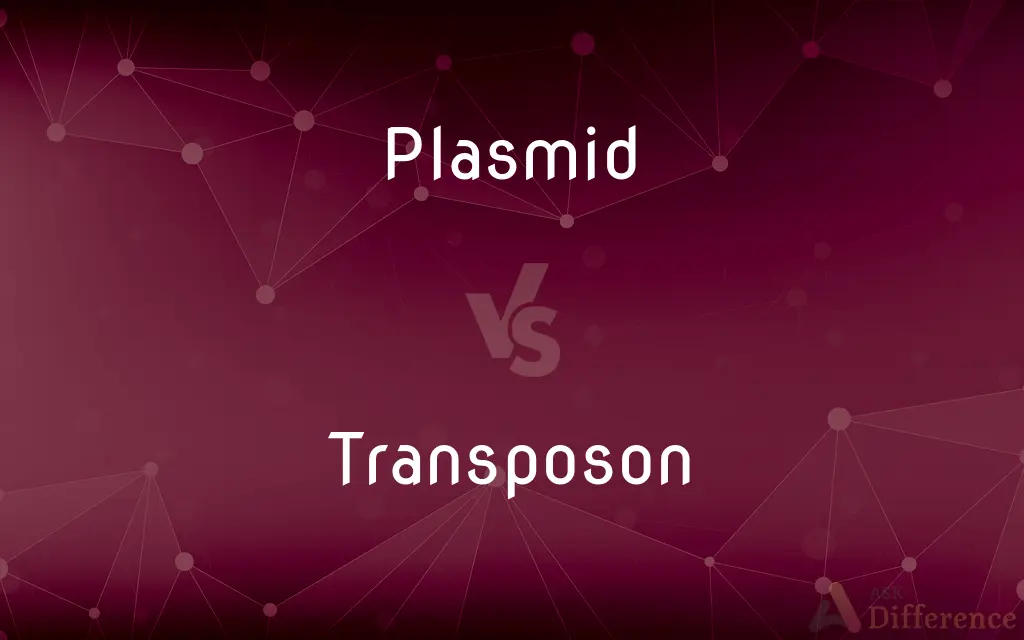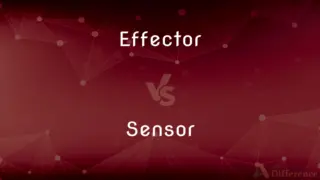Plasmid vs. Transposon — What's the Difference?
By Tayyaba Rehman — Updated on September 28, 2023
Plasmid is a small, circular DNA molecule within bacteria, separate from chromosomal DNA, whereas Transposon is a DNA sequence that can change its position within the genome, affecting gene function and expression.

Difference Between Plasmid and Transposon
Table of Contents
ADVERTISEMENT
Key Differences
Plasmid and Transposon are genetic elements with different characteristics and functionalities in the biological realm. A plasmid is a small, circular, double-stranded DNA molecule that is distinct from a cell's chromosomal DNA, typically found in bacteria. Plasmids are capable of replicating independently of chromosomal DNA and are often involved in the transfer of genes between bacteria, playing a critical role in antibiotic resistance and the acquisition of novel metabolic pathways.
On the other hand, a transposon, often termed a “jumping gene”, is a DNA sequence that can change its position within the genome, potentially creating or reversing mutations and altering the cell's genetic identity and genomic size. Transposons are found in almost all organisms and are critical contributors to genetic diversity and evolution. They can disrupt the function of the genes they jump into and can play significant roles in the evolution and adaptation of organisms by mobilizing and rearranging genetic material.
While plasmids function as independent DNA molecules, often transferring beneficial genes between organisms, transposons alter genetic composition by changing their positions within the genome. Plasmids are key vehicles in genetic engineering, allowing the insertion of foreign genes into bacteria for cloning or protein production. In contrast, the movement of transposons, by either cut-and-paste or copy-and-paste mechanisms, can lead to mutations, insertions, deletions, or even chromosomal rearrangements, impacting genetic diversity and evolution.
In essence, the plasmid acts as an independent genetic element, capable of autonomous replication and typically beneficial gene transfer, particularly among prokaryotic organisms. The transposon, with its ability to move within the genome, serves as an agent of genetic variation and evolution in both prokaryotic and eukaryotic entities, affecting gene function and expression, and potentially leading to new genetic combinations and traits.
Plasmids and transposons illustrate the dynamic nature of the genome, highlighting the plasticity and adaptability of genetic material. While plasmids play a pivotal role in horizontal gene transfer and microbial adaptation, transposons facilitate genomic variability and evolution, unveiling the intricacies of genetic modulation and evolutionary biology.
ADVERTISEMENT
Comparison Chart
Definition
Small, circular DNA molecule, typically in bacteria
DNA sequence that can change its position within a genome
Role
Transfers genes between bacteria
Creates genetic diversity by inducing mutations
Occurrence
Predominantly in prokaryotes
Found in almost all organisms
Replication
Can replicate independently of chromosomal DNA
Does not replicate independently; moves within the genome
Impact on Host Organism
Can confer beneficial traits such as antibiotic resistance
Can disrupt gene function, leading to genetic variability
Compare with Definitions
Plasmid
A small, circular, self-replicating DNA molecule separate from chromosomal DNA, typically in bacteria.
The scientist used a plasmid to introduce a new gene into a bacterial cell.
Transposon
A DNA sequence capable of moving to a new position within the genome.
The movement of the transposon caused a mutation in the gene.
Plasmid
Genetic structure in a cell that can replicate independently of chromosomes.
Plasmids often carry genes that confer selective advantage to their host, such as antibiotic resistance.
Transposon
A segment of DNA that can induce mutations by jumping from one location to another within the genome.
The insertion of a transposon into a gene can disrupt its function.
Plasmid
A molecular tool in genetic engineering to introduce foreign genes into bacteria.
Scientists often use plasmids to produce large amounts of proteins in bacteria.
Transposon
A mobile genetic element that can alter gene function and genome structure.
Transposons play a critical role in shaping the structure and function of genomes in various organisms.
Plasmid
A DNA sequence capable of autonomous replication and gene transfer between cells.
The plasmid was used as a vector to clone a specific gene.
Transposon
Genetic element known as “jumping gene” that can change its position in the genome.
Transposons contribute to genetic diversity and evolution by rearranging genetic material.
Plasmid
Circular DNA that can replicate independently and is not essential for the host but may confer a selective advantage.
The bacterium harboring the plasmid had a survival advantage in antibiotic-rich environments.
Transposon
An entity in DNA that can move around and cause genetic variation, impacting evolutionary processes.
The spread of transposons within a population can lead to the emergence of new traits and adaptations.
Plasmid
A plasmid is a small, extrachromosomal DNA molecule within a cell that is physically separated from chromosomal DNA and can replicate independently. They are most commonly found as small circular, double-stranded DNA molecules in bacteria; however, plasmids are sometimes present in archaea and eukaryotic organisms.
Transposon
A segment of DNA that is capable of moving into a new position within the same or another chromosome or plasmid. Also called jumping gene.
Plasmid
A circular, double-stranded unit of DNA that replicates within a cell independently of the chromosomal DNA. Plasmids are most often found in bacteria and are used in recombinant DNA research to transfer genes between cells.
Transposon
(genetics) A segment of DNA that can move to a different position within a genome, or to the genome of another species.
Plasmid
(cytology) A loop of double-stranded DNA that is separate from and replicates independently of the chromosomes, most commonly found in bacteria, but also in archaeans and eukaryotic cells, and used in genetic engineering as a vector for gene transfer.
Transposon
A segment of DNA that can become integrated at many different sites along a chromosome (especially a segment of bacterial DNA that can be translocated as a whole)
Plasmid
A piece of DNA, usually circular, functioning as part of the genetic material of a cell, not integrated with the chromosome and replicating independently of the chromosome, but transferred, like the chromosome, to subsequent generations of daughter cells. In bacteria, plasmids often carry the genes for antibiotic resistance; they are exploited in genetic engineering as the vehicles for introduction of extraneous DNA into cells, to alter the genetic makeup of the cell. The cells thus altered may produce desirable proteins which are extracted and used; in the case of genetically altered plant cells, the altered cells may grow into complete plants with changed properties, as for example, increased resistance to disease.
Plasmid
A small cellular inclusion consisting of a ring of DNA that is not in a chromosome but is capable of autonomous replication
Common Curiosities
Can Plasmids transfer between different species of bacteria?
Yes, plasmids can facilitate horizontal gene transfer between different species of bacteria, spreading traits like antibiotic resistance.
Do all bacteria contain Plasmids?
No, not all bacteria contain plasmids, but many do, especially those exposed to stressful conditions like antibiotic presence.
How do Transposons move within the genome?
Transposons can move either by a “cut and paste” mechanism or a “copy and paste” mechanism, leading to their insertion at new genomic locations.
Can Transposons contribute to evolution?
Yes, by generating genetic diversity and causing mutations, transposons play a significant role in the evolution of species.
Do Transposons only cause harmful mutations?
No, while transposons can disrupt gene function and cause harmful mutations, they also create genetic diversity, which can be beneficial.
What is a Plasmid?
A plasmid is a small, circular, self-replicating DNA molecule, separate from chromosomal DNA, often found in bacteria.
Can Transposons cause diseases in humans?
Yes, the movement of transposons can disrupt gene function and regulation, leading to diseases, including cancers.
What is a Transposon?
A transposon is a DNA sequence that can change its position within the genome, potentially affecting gene function and expression.
Do Plasmids always benefit their host cells?
While plasmids often carry beneficial genes, like antibiotic resistance, they may also impose a metabolic burden on host cells.
Can Plasmids exist independently of chromosomal DNA?
Yes, plasmids can replicate independently of chromosomal DNA and are not essential for the host cell's survival.
Can Plasmids be used in genetic engineering?
Absolutely, plasmids are vital tools in genetic engineering for cloning genes and producing recombinant proteins.
Are Plasmids only found in bacteria?
While predominantly found in bacteria, plasmids are also identified in archaea and eukaryotic organisms, such as yeast.
Are Plasmids and Transposons essential for life?
While they can provide advantages and contribute to genetic diversity and evolution, neither plasmids nor transposons are essential for the basic survival of organisms.
Can Transposons duplicate genes?
Yes, some transposons can duplicate genes during their movement, leading to the evolution of new gene functions.
Are Transposons only present in prokaryotes?
No, transposons are found in almost all organisms, including prokaryotes and eukaryotes, impacting genomic structure and function.
Share Your Discovery

Previous Comparison
Effector vs. Sensor
Next Comparison
Seppuku vs. HarakiriAuthor Spotlight
Written by
Tayyaba RehmanTayyaba Rehman is a distinguished writer, currently serving as a primary contributor to askdifference.com. As a researcher in semantics and etymology, Tayyaba's passion for the complexity of languages and their distinctions has found a perfect home on the platform. Tayyaba delves into the intricacies of language, distinguishing between commonly confused words and phrases, thereby providing clarity for readers worldwide.













































